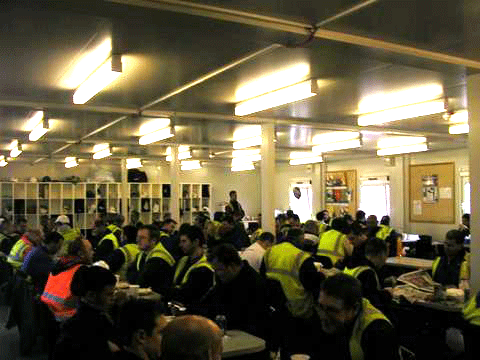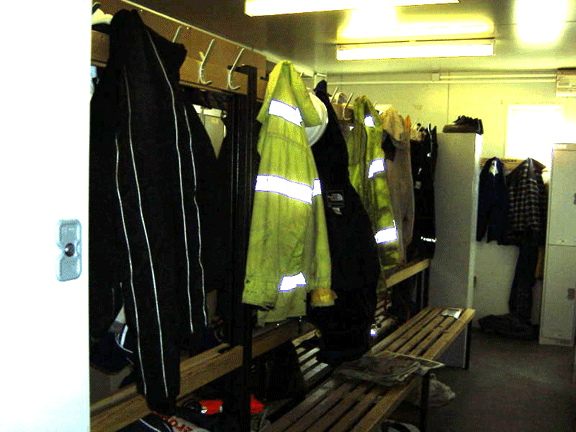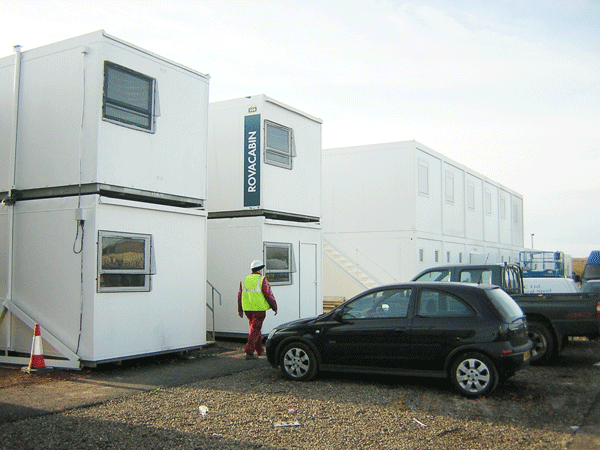Current
situation:
The following assumptions have been made.
Heating
behaviour of occupants:
Lighting
behaviour of occupants:
The results
shown in the tables below have been arrived from a combination
of ESP-r simulations and calculations.
|
|
Annual energy demand
|
Lighting
|
226.5
kWh |
|
Heating |
1235
kWh |
|
|
For
a typical winter day (7:00 – 18:00) |
Thermal percentage
dissatisfied
|
40.53 %
(16.51% standard variation) |
|
Thermal comfort 1 |
1 h
(mainly overheated) |
1
Hours
per day where the dry resultant temperature lies between 20°C
and 22°C
Proposed
Situation:
Following energy efficiency measures have been applied
The
following assumptions have been made:
Heating:
Lighting:
-
25 % less
lamp rating (HF control)
-
65 % annual
savings through day light control (hardly surrounding
buildings; clean windows, little use of blinds)
The results
shown in the tables below have been arrived from a combination
of ESP-r simulations and calculations.
|
|
Annual energy demand
|
Lighting
|
59.5
kWh |
|
Heating |
471 kWh
|
|
|
For
a typical winter day (7:00 – 18:00) |
Thermal percentage
dissatisfied
|
8.25 %
(10.05% standard variation) |
|
Thermal comfort 1 |
10 h
(mainly overheated) |
1
Hours
per day where the dry resultant temperature lies between 20°C
and 22°C
Back to Top
The canteen
consists of 5 cabins and has the following characteristics:
-
Occupied by
workers from 10:00 to 11:00 and 13:00 to 15:00
-
Occupied by
cleaner from 11:00 to 12:00
-
4 x 2kW
heaters and 25 x 36W lights

-
Infiltration: 2ac/h during tea and lunch time, otherwise
1ac/h
Current
situation:
The following assumptions have been made.
·
Heating behaviour of occupants:
Lighting
behaviour of occupants:
The results
shown in the tables below have been arrived from a combination
of ESP-r simulations and calculations.
|
|
Annual energy demand
|
Lighting
|
2831.4
kWh |
|
Heating |
4680
kWh |
|
|
For
a typical winter day (8:00 – 16:00) |
Thermal percentage
dissatisfied
|
52.63 %
(19.77% standard variation) |
|
Thermal comfort 1 |
0.5 h
(mainly overheated) |
1
Hours
per day where the dry resultant temperature lies between 20°C
and 22°C
The picture
below demonstrates the dry resultant temperature inside the
canteen on a typical winter day. The upper line shows the dry
resultant temperature, the lower line shows the ambient
temperature.

Ambient and canteen’s dry resultant temperature
There is a
discomfort inside the canteen due to overheating and poor air
quality.
Proposed
Situation:
Following energy efficiency measures have been applied.
-
High
frequency ballasts
-
Occupancy
sensor for lights
-
1.5kW
heater with automatic temperature control (set from 8:00 to
15:00)
-
5
ventilators with 550m3/hr with heat recovery and
CO2 sensor (rated 150W)
The
following assumptions have been made:
Heating:
Lighting:
Ventilation:
The results
shown in the tables below have been arrived from a combination
of ESP-r simulations and calculations.
|
|
Annual energy demand
|
Lighting
|
764.5
kWh |
|
Heating |
3550
kWh |
|
Ventilation |
780 kWh |
|
|
For
a typical winter day (8:00 – 16:00) |
Thermal percentage
dissatisfied
|
13.78 %
(17.95% standard variation) |
|
Thermal comfort 1 |
4 h
(mainly overheated) |
1
Hours
per day where the dry resultant temperature lies between 20°C
and 22°C
As stated in the table, the dry resultant temperature cannot
be maintained over the whole day.
However, a
comfort temperature of 20°C dry resultant temperature is
maintained during tea and lunchtime as shown in the graph below.
The upper line shows the dry resultant temperature, the lower
line shows the ambient temperature.

Ambient and
canteen’s dry resultant temperature
Back to Top
The drying room
consists of 2 and a half cabins and has the following characteristics:
-
Intermittent occupied (mainly at tea and lunchtime and
before work end)
-
2 x 2kW and
8 x 150W heaters
-
9 x 36W
lamps
-
Infiltration: 1.5 ac/hr during working hours
Current
situation:
The following assumptions have been made
·
Heating behaviour of occupants:
-
0:00
–24:00: 2kW heaters on medium power (2 x 1200W)
-
0:00
–24:00: 150W heaters on full power (8 x 150W)
Lighting
behaviour of occupants:
The results
shown in the tables below have been arrived from a combination
of ESP-r simulations and calculations.
|
|
Annual energy demand
|
Lighting
|
1019.3
kWh |
|
Heating |
22464
kWh |
|
|
For
a typical winter day (7:00 – 18:00) |
Thermal percentage
dissatisfied
|
88.37%
(24.3% standard variation) |
|
Thermal comfort 1 |
0 h
(always overheated) |
1
Hours
per day where the dry resultant temperature lies between 20°C
and 22°C
The picture
below demonstrates the dry resultant temperature and ambient
temperature inside the drying room for a typical winter working
day. The upper line shows the dry resultant temperature, the
lower line shows the ambient temperature

Ambient and cabin’s dry resultant temperature
It is shown
that a dry resultant temperature about 40°C is maintained 24
hours during working days without ventilation. It is obvious
that there is wastage of energy in addition to the problem that
the clothes do not dry overnight.
Proposed
Situation:
Following energy efficiency measures have been applied.
·
-
High frequency ballasts
-
Occupancy sensor for lights
-
5 x 1.5 kW heater with automatic control to replace all existing heaters
-
3 Ventilators with 220m3/hr with heat recovery and humidity sensor (rated 130W)
The following
assumptions have been made:
·
Heating:
-
Heating
control to maintain 20°C dry bulb temperature (24h per day)
·
Lighting:
-
25 % less
rating (HF ballast)
-
Lights
switched on for 20% of working hours
·
Ventilation:
-
Switched
on 24h per working day
-
3 AC/hr per cabin with 75% heat recovery
The results
shown in the tables below have been arrived from a combination
of ESP-r simulations and calculations.
|
|
Annual energy demand
|
Lighting
|
152.9
kWh |
|
Heating |
7,567.6
kWh |
|
Ventilation |
2,433.6
kWh |
|
|
For
a typical winter day (7:00 – 18:00) |
Thermal percentage
dissatisfied |
6.03%
(0.43% standard variation) |
|
Thermal comfort
1 |
10.5 h
(always overheated) |
1
Hours
per day where the dry resultant temperature lies between 20°C
and 22°C
The picture
below demonstrates the dry resultant temperature and ambient
temperature inside the drying room for a typical winter working
day. The upper line shows the dry resultant temperature, the
lower line shows the ambient temperature

Ambient and cabin’s dry resultant temperature
It is shown
that a dry resultant temperature about 20°C is maintained 24
hours during working days. Thus, the drying room of improved
standard provides an effective environment for clothes drying.
Back to Top
The
subcontractor’s cabin is a 9.5m x 3m cabin with the following
characteristics:
-
3 occupants
for 5 hours per day

-
1 computer
(7:00 –18:00)
-
2 x 2kW
heater and 5 x 58W lamps
-
Infiltration: 4ac/h (doors open)
Current
situation:
The following assumptions have been made.
· Heating behaviour of occupants:
-
7:00 - 9:00
both heaters on maximum power (2 x 2000W)
-
9:00 -
18:00 both heaters on middle power (2 x 1250W)
Lighting
behaviour of occupants:
The results
shown in the tables below have been arrived from a combination
of ESP-r simulations and calculations.
|
|
Annual energy demand
|
Lighting
|
912 kWh |
|
Heating |
3965
kWh |
|
|
For
a typical winter day (7:00 – 18:00) |
Thermal percentage
dissatisfied |
24.34%
(30.58% standard variation) |
|
Thermal comfort
1 |
2 h
|
1
Hours
per day where the dry resultant temperature lies between 20°C
and 22°C
Pictures below
demonstrate the dry resultant temperature inside the
subcontractor’s cabin for a typical winter day. The upper line
shows the dry resultant temperature, the lower line shows the
ambient temperature

Ambient and
cabin’s dry resultant temperature
It is
demonstrated that the required dry resultant temperature of 20°C
cannot be maintained. During a typical winter day the dry
resultant temperature inside the subcontractor’s cabin will
typically be below the required comfort level. Thus, discomfort
will be experienced.
Proposed
Situation:
Following energy efficiency measures have been applied.
·
Improve insulation
-
36W T5
tubular fluorescent lights
-
Occupancy
sensor for lights
-
1.5 kW
heater with automatic temperature control (start time: 6:00)
The following
assumptions have been made:
Heating:
Lighting:
The results
shown in the tables below have been arrived from a combination
of ESP-r simulations and calculations.
|
|
Annual energy demand
|
Lighting
|
191 kWh |
|
Heating |
1567
kWh |
|
|
For
a typical winter day (7:00 – 18:00) |
Thermal percentage
dissatisfied |
10.69%
(18.12% standard variation) |
|
Thermal comfort
1 |
10 h
|
1
Hours
per day where the dry resultant temperature lies between 20°C
and 22°C
Pictures below
demonstrate the dry resultant temperature inside the
subcontractor’s cabin for a typical winter day. The upper line
shows the dry resultant temperature, the lower line shows the
ambient temperature

Ambient and
cabin’s dry resultant temperature
It is shown
that a dry resultant temperature above 20°C is maintained
between 8:00 and 18:00. Thus, the cabin of improved standard
provides a comfortable working environment for subcontractors.
Back to Top
The following
two tables summarise all results gained from the case study for:
Energy
Savings and Investments